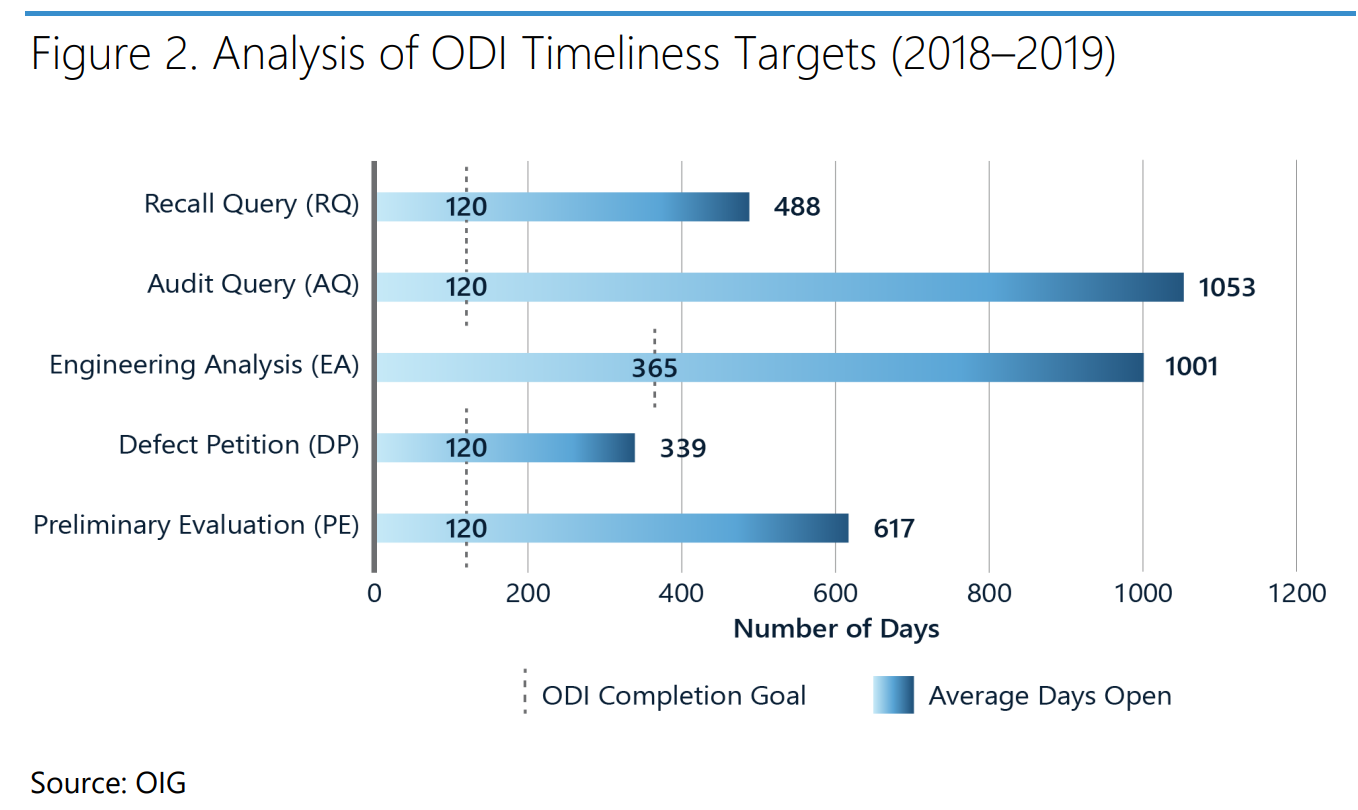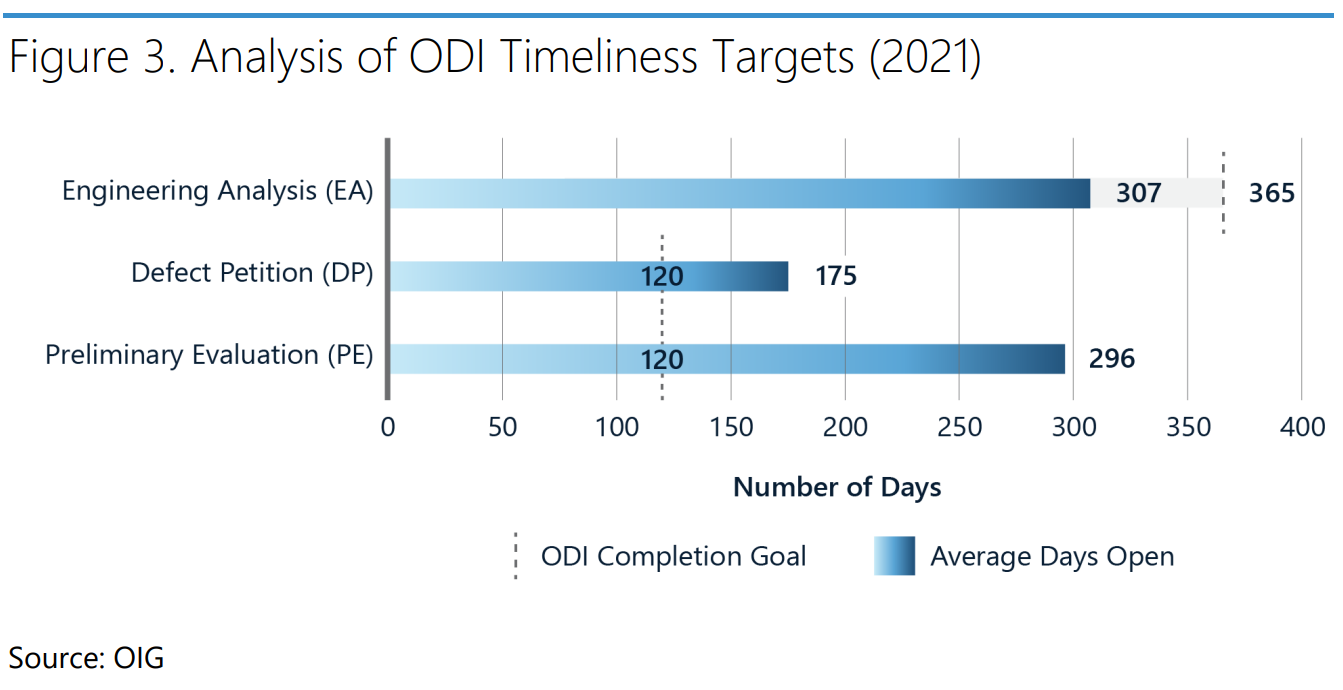
Audit: NHTSA ODI lacks timeliness in recall investigations, notices
By onAnnouncements
An internal audit by the Office of Defects Investigation (ODI) has found that the office lags behind in improving vehicle safety recall investigation timeliness and informing the public in a timely manner.
“NHTSA’s ODI has made progress promoting a safer transportation system for the traveling public by restructuring its office, modernizing its data repository and analysis systems, and enhancing its risk-based investigative processes to assess safety-related defects,” the audit report states. “However, ODI did not meet its timeliness goals for the five types of investigations we examined, and the Agency did not upload investigation documentation to its public website in a timely manner.
“ODI does not have an integrated information system to facilitate the safety defect investigation and recall processes. Furthermore, ODI does not consistently document information used for investigating and identifying potential defects and unsafe motor vehicles or motor vehicle equipment in the Agency’s internal and external files. In addition, ODI does not consistently follow its procedures for issue escalation and
lacks guidance for other pre-investigative efforts.”
In a memorandum attached to the report, Assistant Inspector General for Surface Transportation Audits David Pouliott wrote that the restructuring and revision of ODI and its processes began in 2016 and five stages were to be followed: data collection, data review, issue review, investigation, and recall management.
The Inspector General’s Office called for the audit, in part, based on recommendations given to ODI following previous audits.
The audit uncovered from a sample of 27 investigations conducted in 2018-2019 that all but one failed to meet NHTSA’s timeliness targets. And in a sample of eight 2021 investigations, only one met the targets.
ODI says the goals weren’t met due to an “overwhelming increase in correspondence, taking time to craft petition denials in a tactful manner, prioritizing cooperative working relationships with manufacturers, and relying on external stakeholders to respond to ODI’s request.
The audit report contends that ODI’s lack of timeliness in completing investigations limits its ability to respond to rapidly evolving or severe risks to vehicle safety and the office’s public accountability. In addition, ODI fails to meet its operating procedures and federal standards when recording key documentation in its when analyzing safety-related defects.
“For example, in 22 of 24 applicable ODI investigations in our 2018–2019 sample, the files were missing documentation. Further, in all 8 of the ODI investigations in our 2021 sample, ODI did not follow the written procedures necessary for investigators to evaluate the risk of harm posed by potential defects. …41 percent of ODI’s records were missing issue prioritization scores, which included serious allegations such as car seat base separation, fires, and fuel leaks.”
“ODI’s lack of consistency in following its issue escalation procedures could increase risk to the traveling public because unsafe vehicles or equipment may not be investigated, repaired, or recalled.”
The audit report says that ODI’s reliance on multiple legacy information systems and its inconsistency in following its process of increasing the depth of its investigations.
Recommendations from the most recent audit are:
-
- Assess and/or revise timeliness goals to ensure they’re realistic and attainable;
- Develop and implement procedures for audit query and timeliness query investigations;
- Develop and implement an accountability system to improve ODI’s compliance with processes, such as notifying petitioners of its decision within 120 days, documenting timely pre-investigative and investigative supervisory reviews and timely reviews of manufacturer-provided data, developing and following a written plan for all phases of investigations, and documenting substantive pre-investigative and investigative-related communication with manufacturers;
- Develop and implement improved procedures for ensuring investigation documentation is uploaded to the public website;
- Ensure consistent application by each of the divisions, and develop a system of accountability to ensure compliance with the revised procedures when issuing and approving a manufacturer-requested information request letter response extension and requesting information from manufacturers;
- Develop and implement procedures for the planned integrated information system including a user guide for how to document decisions, actions taken, and communication with stakeholders as well as where to store specific pre-investigative and investigative documentation;
- Complete expeditious integration of the information systems for pre-investigation and investigation processes, including data migration;
- Develop and implement a consistent procedure to govern ODI’s practice of negotiating a resolution of potential safety defects with manufacturers;
- Develop and implement a requirement that all information used to support decisions made during the pre-investigative and investigative processes are documented and retained, including the supporting information for safety defect analyses and related briefings;
- Develop and implement guidance for determining which issues investigators should present at Hot Issues meetings based on ODI’s riskbased analysis process;
- Reconcile the risk matrix and issue escalation procedures and establish specific guidance on when an investigation should be opened;
- Develop a definition of high-interest topics and the actions needed to address these issues.
NHTSA concurred with recommendations two through seven, nine, and 10-12 as well as most of recommendation one. The agency didn’t agree with recommendation 8 “because it believes ODI’s investigative procedures and associated training sufficiently address the underlying goal of achieving an appropriate safety outcome in an investigation,” the audit report states.
NHTSA did agree, however, to document negotiation outcomes in its official record. All recommendations are considered resolved by the inspector general but are pending implementation.
Images
Featured image credit: metamorworks/iStock


